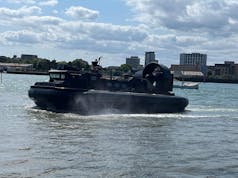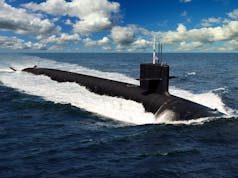Standing NATO Mine Countermeasures Group 1 (SNMCMG1) completed successful historical ordnance disposal operations (HODOPS) off the coast of France, Feb. 20, including disposal of a 700-kilogram mine.
After leaving Ostend on Feb. 3, SNMCMG1 flagship German Navy tender FGS Donau (A516) joined mine-hunting units Estonian Navy ENS Ugandi (M315), Royal Netherlands Navy HNLMS Zierikzee (M862), and French Navy FS Andromede (M643) as part of the Very High Readiness Joint Task Force (VJTF)-(Maritime) working together under NATO for the operation.
The crew of FS Andromede detected the LMB air-laid ground mine, a remnant from World War I or II, which contained approximately 700 kilograms of explosives. They immediately began coordinating with French authorities in preparation to neutralise the mine.
French divers from the ship placed two tactical explosive charges on the mine. After calculating minimum safety distances, the divers detonated the mine on Feb. 13 sending a large plume of water into the air and eliminating the threat of unintentional explosion.














A mine left over from 80 years ago? That’s surprising to say the least.
IWM (and other sources) make it clear LMB was a WWII device developed between 1928 & 1934.
I would assume that there is a huge amount of unexploded ordinance lying around the North Sea and English Channel (La Manche).
One suspects they will be dredging these things up, or finding them when looking for them, for many years to come.
Oh I’m not sure. Before long there will be all sorts of devices scanning the sea bed looking for all sorts of good stuff. They will probably note any potential devices which they will pass on. More interesting stuff which might be worth a few quid will be ‘rescued’ and sold for a profit. The days of the contents of the seas and oceans being a mystery are probably coming to an end.
I found the reference to WWI rather puzzling?
Indeed – large area and a huge amount of ordnance on the bottom. Some of it dumped post war.
Definitely a job for robotised scanning missions. How the disposal works is another matter!
There does come a point when the casings corrode through exposing the contents to salt water and other sea chemicals as well as bacteria. Be interesting to know what the bacterial breakdown pathways for HE are…….
I’ll answer my own question
https://www.sciencedirect.com/science/article/pii/S2214914717301058#:~:text=Many%20microorganisms%20are%20capable%20to,under%20aerobic%20and%20anaerobic%20conditions.
There was at least one box area in the southern North Sea chart marked as an explosives dumping ground. That’s quite apart from all the more randomly dropped or sunk munitions or ammo etc sunk with the ships that were carrying them.
BTW I don’t think any WW1 aircraft could carry a 700kg load.
I agree. It is all over the place. Probably only solved by time and the tinworm!
700kg could only have been carried by an airship in WWI?
There was several places designated as drop areas in WW2 for aircraft returning with ordinance that required to be jettisoned before landing. From memory one near Sandwich, one of Yorkshire. Possibly one in the Wash. It was also fairly common for crews to loose a stick of bombs on the way out because the aircraft would not climb or handling issues. There are firms now making a fortune mapping the seabed prior to windfarm and pipeline operations.
Not really. If anyone served in the RNR in the late 80s early 90s we had steel hulled River class minesweepers going out into the North Sea on a deep trawl searching for moored mines. Oh the days when the RNR had allocated ships, they also had the Archer class. God the Rivers are the only ships that I ever got seasick on. Three days with my head over the side, it would not have been to bad but the North Sea had blue skies,bright sunshine and was like a milk pond.
Personally I do think RNR should have some frigates that do have a core full time crew and RNR crew in rotation.
Don’t give the tories a brain wave ,they might want to buy it for national defence needs 😏 😜 😉
I was listening to the Times radio podcast the other day and it mentioned that the Ukrainians had destroyed a small river mine off the coast of Odesa , Mines which had been flooded into the Black Sea after Moscow blew up that dam. They then described that it was a small mine designed to punch a hole into ships and not to be confused with large sea mines (Like the one above) which are designed to create an huge air gap under a ship , which it turn results in the ship breaking its back due to a lack of support, learn new something everyday
Really…. did you not know that ? ….. How strange….. I thought you were a know It all….. Maybe you aren’t after all….. 🙄
Frank,
All i see here is a bloke who having lost an argument , feels the need to get a little dig in, because he has lost face. how pathetic, but then hard men like you are only hard over the net, we both know you wouldn’t say boo to a ghost, never mind a bloke to his face. But hey you continue acting like a 3 year old, it will soon time for you to have a nap, and no doubt you will fell better afterward.
In Germany where I live, we still have 200 or more bombs found every year. It is even standard procedure and mandatory to check allied WW2 air strike reconnaissance photos which were bought after the war before being allowed to start digging.
The bombs found are in different states, but usually still dangerous. I guess in Coventry and Bristol it is not that different. In the sea, lots of unexploded ordnance remains. It has been SOP to disarm them in the Baltic sea for decades already, regularly used for practice by mine divers.
There will come a time when those are no longer dangerous, but depending on where they are, it will take time. Laos is another example.
Calculating minimum safety distances 😅